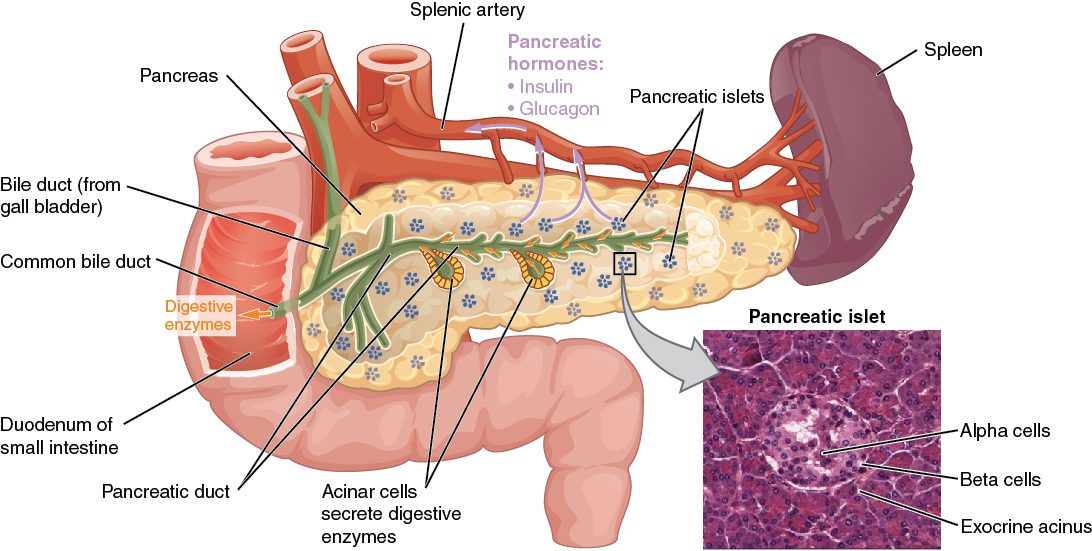The pancreas is an organ that is situated deep in the abdominal cavity.
It is surrounded by the liver, the spleen, and the small intestine. The pancreas acts as an endocrine gland (that is a gland that produces substances to the blood stream directly without a duct) and an exocrine gland (that releases substances through a duct). As an endocrine gland, the pancreas releases insulin that controls the blood sugar level. As an exocrine gland, the pancreas secretes digestive juices.
Most of the pancreas (95%) act as an exocrine gland. It produces the pancreatic fluid which contains digestive enzymes. The pancreatic juices are released into the duodenum together with the bile and they help in the digestion of fats, proteins, and carbohydrates. These enzymes include trypsin and chymotrypsin that digest proteins, amylase that breaks down carbohydrates, and lipase that breaks down fats into fatty acids and glycerol.
The rest of the pancreas acts as an endocrine gland with cells known as islets of Langerhans. These cells produce insulin that helps glucose move from the blood stream to the muscles and tissues. Therefore, the pancreas controls the normal glucose level in the blood and enables the use of glucose for energy.
The pancreas lies in the upper left part of the abdomen. However, due to its deep location, most of the pancreatic tumors cannot be felt by palpation. This makes most pancreatic tumors or cancers hard to detect till they are large enough to interfere with the function of the duodenum.

The pancreas is a flattened organ that ranges from 12-18 centimeters in length. It consists of a head, neck, body, and tail. The head is the largest part of the pancreas and lies on the right side of the abdominal cavity, while the tail is extended to the left side. The pancreas contains a duct known as the pancreatic duct.
Any conditions affecting the pancreas will, in turn, affect the whole body.
If the pancreatic juice is reduced, the food won’t be properly digested and absorbed. If the endocrine function of the pancreas is affected, then insulin won’t be produced in enough quantities and type-2 diabetes occurs. Type-1 diabetes occurs when the immune system of the body attacks the beta cells of the pancreas due to genetic or environmental causes. It is an autoimmune disease.
Pancreatitis is a disease where the pancreas is inflamed. The digestive juices released by the pancreas end up digesting part of the pancreas itself. It can be an acute situation that lasts for a short time and can be treated. Or it can also be a chronic inflammation lasting for a long time.
Pancreatic cancer is another serious disease that can affect the pancreas.
It is hard to detect until it reaches an advanced level. Pancreatic cancer involves the formation of masses called tumors due to cells growing uncontrollably and these cells start spreading to the surrounding organs and blood vessels.
Pancreatic cancer mostly affects the exocrine part of the pancreas and is thus known as pancreatic exocrine cancer. In less likely cases, cancer affects the endocrine cells of the pancreas and is known as pancreatic endocrine cancer and islet cell tumors.
The risk factors of pancreatic cancer include a family history of pancreatic cancer, genetic makeup, obesity, smoking, excessive drinking and old age. Pancreatic cancer can have serious complications. It can lead to weight loss due to the pancreatic tumor pressing the stomach and due to the side effects of chemotherapy such as nausea and vomiting.
Also, the body is unable to properly digest and absorb food, so the it cannot obtain enough of the necessary nutrients for normal functioning. It can also lead to jaundice if the tumor is blocking the bile duct and preventing the release of bile. The result is yellow discoloration of the skin and the eye whites.
It is safer to have a healthy lifestyle in order to avoid pancreatitis and pancreatic cancer. Make sure you abstain from smoking and drinking alcohol. Try to eat a low-fat diet. Avoid unhealthy foods such as refined flour, processed food, and sugar. These foods directly damage the pancreas.
Take sufficient time to implement a plan to detoxify your pancreas by drinking sufficient fluids and eating foods rich in antioxidants. There are also many recipes for juices that strengthen your pancreas and promote its health.